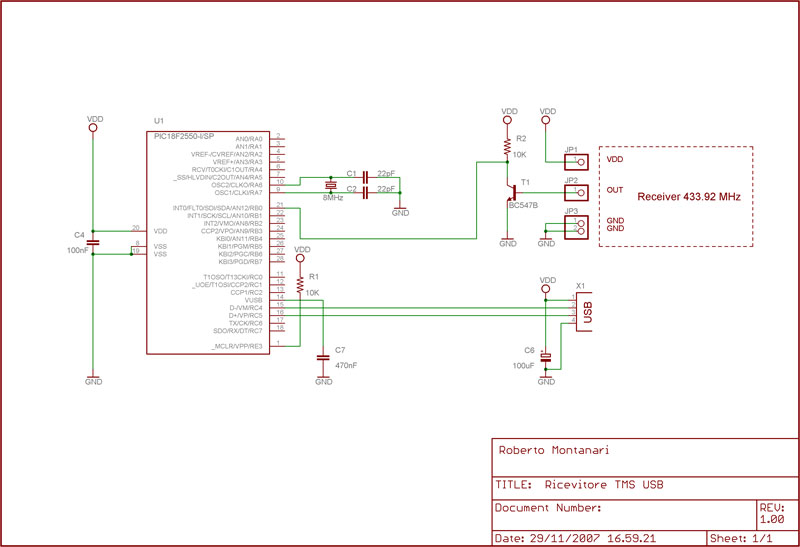
Telephone status monitor

The LED signifies the status of a remote telephone. The light remains off when the phone is hung up. It emits a steady glow when the phone is off the hook, and it flashes intermittently while the phone is ringing and for five seconds after the ringing ceases. The flashing oscillator operates continuously but can only drive the LED when a ringing signal discharges the one-shot capacitor to enable NAND gate G3. Consequently, a single oscillator can manage multiple phone lines.
The described circuit utilizes an LED to visually communicate the status of a remote telephone line, incorporating a flashing oscillator and a NAND gate for control. When the telephone is not in use (hung up), the LED remains off, indicating an idle state. When the phone is off the hook, the LED illuminates steadily, signaling that the line is active. During incoming calls, the LED flashes in response to the ringing signal, providing an immediate visual alert.
The flashing oscillator, designed to operate continuously, serves as the heart of the circuit. Its output is contingent upon the presence of a ringing signal. When a ring signal is detected, it triggers a one-shot capacitor, which in turn enables NAND gate G3. This gate is responsible for controlling the LED's operation during the ringing state. The capacitor discharges quickly, allowing the NAND gate to toggle the LED on and off, creating a flashing effect. After the ringing stops, the LED continues to flash for an additional five seconds, ensuring that the user is aware of the missed call.
The circuit's design is efficient, as a single oscillator can manage multiple phone lines. This is achieved by connecting the oscillator output to multiple NAND gates, each corresponding to a different phone line. Each gate will activate the LED for its respective line based on the state of the one-shot capacitor, allowing for a compact and effective solution in multi-line telephone systems. This design is particularly useful in environments where monitoring multiple lines is necessary, such as in offices or call centers. Overall, the circuit provides a reliable method for indicating telephone status through a simple visual cue.The LED indicates the status of a remote telephone. The light is off if the phone is hung up. It shines steadily if the phone is off hook, and it flashes on and off while phone rings and for 5 seconds after ringing stops. The flashing oscillator operates continuously but can drive the LED only when a ringing signal discharges the one shot capacitor to enable NAND gate G3
Thus, one oscillator handles several phone lines. 🔗 External reference
The described circuit utilizes an LED to visually communicate the status of a remote telephone line, incorporating a flashing oscillator and a NAND gate for control. When the telephone is not in use (hung up), the LED remains off, indicating an idle state. When the phone is off the hook, the LED illuminates steadily, signaling that the line is active. During incoming calls, the LED flashes in response to the ringing signal, providing an immediate visual alert.
The flashing oscillator, designed to operate continuously, serves as the heart of the circuit. Its output is contingent upon the presence of a ringing signal. When a ring signal is detected, it triggers a one-shot capacitor, which in turn enables NAND gate G3. This gate is responsible for controlling the LED's operation during the ringing state. The capacitor discharges quickly, allowing the NAND gate to toggle the LED on and off, creating a flashing effect. After the ringing stops, the LED continues to flash for an additional five seconds, ensuring that the user is aware of the missed call.
The circuit's design is efficient, as a single oscillator can manage multiple phone lines. This is achieved by connecting the oscillator output to multiple NAND gates, each corresponding to a different phone line. Each gate will activate the LED for its respective line based on the state of the one-shot capacitor, allowing for a compact and effective solution in multi-line telephone systems. This design is particularly useful in environments where monitoring multiple lines is necessary, such as in offices or call centers. Overall, the circuit provides a reliable method for indicating telephone status through a simple visual cue.The LED indicates the status of a remote telephone. The light is off if the phone is hung up. It shines steadily if the phone is off hook, and it flashes on and off while phone rings and for 5 seconds after ringing stops. The flashing oscillator operates continuously but can drive the LED only when a ringing signal discharges the one shot capacitor to enable NAND gate G3
Thus, one oscillator handles several phone lines. 🔗 External reference





